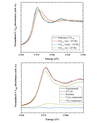issue contents
Actinide Physics and Chemistry with Synchrotron Radiation special issue
Edited by Kristina Kvashnina, Sergei Butorin, Shuao Wang and WeiQun Shi
This virtual issue of Journal of Synchrotron Radiation on Actinide Physics and Chemistry with Synchrotron Radiation collects together articles originally published in earlier issues of the journal.

Cover illustration: Physics and chemistry of the actinide elements can be studied at the atomic and molecular level by state-of-the-art non-destructive techniques at synchrotrons.
facility information
Open  access
access
 access
accessForeword to the virtual special issue of Journal of Synchrotron Radiation on Actinide Physics and Chemistry with Synchrotron Radiation.
Open  access
access
 access
accessSynchrotron radiation based X-ray scattering techniques provide powerful bulk-sensitive probes for actinide materials. Here, selected experiments showing the potential of these techniques in advancing the knowledge of actinides and their compounds are reviewed.
Open  access
access
 access
accessUC and UMeC2 (Me = Fe, Zr, Mo) carbides were studied by the high-energy-resolution fluorescence detected X-ray absorption technique at the U M4 and L3 edges. The data were analyzed using the Anderson impurity model.
Open  access
access
 access
accessBy combining HERFD-XAS at the uranium L1-, L3- and M4-edge with relativistic quantum chemistry calculations the uranium valence electronic structure in KUO3 could be assessed in detail. The contribution of uranium and oxygen states in observed spectral features is discussed.
Open  access
access
 access
accessExploring the opportunities and challenges when studying actinide and lanthanide N-donor ligand systems relevant for separation technologies from the metal and ligand point of view using X-ray spectroscopy techniques and computations.
Open  access
access
 access
accessSoft X-ray spectromicroscopy at the O K-edge, U N4,5-edges and Ce M4,5-edges has been performed on focused ion beam sections of spent nuclear fuel for the first time. Analysis of oxygen spectra using a modified non-negative matrix factorization method is consistent with a thin layer of hyperstoichiometric uranium oxide having been formed at the interface of a sample consisting of primarily UO2, probably formed after sample preparation. The cerium oxidation state is shown to be predominantly trivalent, with a possible small contribution from tetravalent Ce.
Download citation


Download citation


Open  access
access
 access
accessThe first pre-edge feature with an intensity of 0.16 in the S K-edge X-ray absorption spectra of UO2(S2PR2) (R = Ph and o-CF3C6H4) is entirely attributed to the transitions from S 1s orbitals to the unoccupied molecular orbitals due to the mixing between U 5f and S 3p orbitals.
The ThIV adsorption behavior of multilayered Ti3C2Tx MXene with controllable interlayer space has been investigated in detail, and the results indicate that the interlayer of MXene provides numerous adsorption sites for hydrated and intercalated samples. The adsorption mechanism has also been deciphered through spectroscopic characterization by EXAFS, X-ray diffraction and Fourier transform infrared spectroscopy.
Open  access
access
 access
accessThe first systematic study on U-incorporated Nd2Zr2O7 synthesized via a molten salt method for potential actinide immobilization is presented.
Open  access
access
 access
accessA U LIII-edge X-ray absorption spectroscopic investigation of UVI interactions with minor cement minerals, ettringite and hydrotalcite, is reported. The study is supplemented by 27Al magic angle scattering nuclear magnetic resonance spectroscopy, X-ray diffraction and geochemical modelling.
Open  access
access
 access
accessThis work elaborates and evaluates approaches to the construction of 2D speciation maps, in an effort to maximize sensitivity to the U oxidation state at the U L3-edge, applied to a suite of synthetic Chernobyl lava specimens.
Open  access
access
 access
accessMultiple EXAFS LIII-edge spectra of U(VI) model compounds were recorded at the STM beamline of KISI-Kurchatov (Moscow, Russia). The distinct parameters obtained for the U(VI) local structure were used to analyze the sample of radioactively contaminated soil.
Open  access
access
 access
accessThe mechanisms of interaction of thorium and plutonium with Fe storage horse spleen ferritin protein (L subunit) have been described by combining modeling with EXAFS data. The interaction between the L subunits and both actinides appears to be driven by the density of the presence of Asp and Glu residues on the protein shell.
Open  access
access
 access
accessA water-soluble plutonium cluster made of six plutonium atoms decorated by four 1,4,7,10-tetraazacyclododecane-1,4,7,10-tetraacetic acid ligands is characterized by small-angle X-ray scattering (SAXS) and extended X-ray absorption fine structure (EXAFS).
Open  access
access
 access
accessNew experimental EXAFS results for PuO2 and CeO2 nanoparticles in the size range of 2 nm were compared with published data for other lanthanide and actinide dioxides. A conceptual core-shell model with a calculated effective coordination number is proposed to fit the changes in EXAFS.
Open  access
access
 access
accessThe study provides insight into the formation of thorium dioxide nanoparticles in solution using small-angle X-ray scattering.
Open  access
access
 access
accessX-ray absorption spectroscopy was used to probe the interactions between an octadentate hydroxypyridinone chelator and two transuranic elements in microgram quantities – plutonium and berkelium – within buffered solutions. Despite the precedence for chelation-driven stabilization of the tetravalent oxidation state of actinides with this ligand, in situ reductive decomposition yielded plutonium(III) and berkelium(III) coordination complexes.
Open  access
access
 access
accessA spectroelectrochemical setup has been developed to investigate radioactive elements in small (0.7 to 2 ml) volumes under oxidation–reduction (redox) controlled conditions by X-ray absorption spectroscopy (XAS). The cell design is presented together with in situ XAS measurements performed during neptunium redox reactions.
Open  access
access
 access
accessIn situ XANES is a powerful method to collect new experimental data in the U–O phase diagram.
Open  access
access
 access
accessThe capabilities for the investigation of radionuclide materials by high-resolution X-ray emission spectroscopy techniques at the CAT-ACT beamline of the Karlsruhe Institute of Technology (KIT) Light Source have been expanded to allow for the investigation of redox-labile low-concentration samples at cryogenic temperatures.


 journal menu
journal menu








































